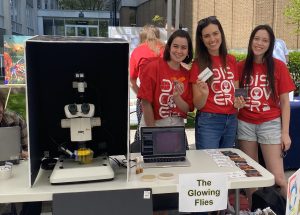 On Saturday, May 13th, St George Street was shut down in front of the Ramsay Wright Building for Science Rendezvous 2023. CSB was out in force to share research activities in Animals, Plants and Bacteria designed by CSB graduate students, staff and Professors.
On Saturday, May 13th, St George Street was shut down in front of the Ramsay Wright Building for Science Rendezvous 2023. CSB was out in force to share research activities in Animals, Plants and Bacteria designed by CSB graduate students, staff and Professors.
Over four hundred people stayed to engage with us out of the thousands who passed by to take a look. “Several families were translating from English to their mother tongue for their young kids, which was a great mirror of Toronto’s diversity,” noted CSB grad student Tatiana Ruiz-Bedoya.
Visitors loved the regenerating flatworms that Professor Ritu Sarpal and Leo Xu showed. Their demonstration showed how gene alterations could make decapitated worms regrow two heads. One young visitor commented “I wish I could have two heads like the mutant flatworms. I would then have two brains and I would be supersmart!”
The movement of tissues during embryo Development was demonstrated by Sirma User with the aid of colourful plaster models and online tools. “A few people (even some kids) wondered about what happens if we take a group of cells and try to grow them outside the embryo,” User recalls, “This is the kind of insightful question we expect from our upper year students and led to some detailed discussions.”
 Developmental Biology was further exemplified through the “Glowing Flies” activity created by Gordana Scepanovic and Veronica Castle. Using a fluorescence microscope, visitors could see glowing GFP-tagged fly embryos. They also looked at living flies in glass vials: “Kids definitely loved making the flies with the temperature sensitive Shibire mutant pass out by warming them up with their hands!”, observed Scepanovic.
Developmental Biology was further exemplified through the “Glowing Flies” activity created by Gordana Scepanovic and Veronica Castle. Using a fluorescence microscope, visitors could see glowing GFP-tagged fly embryos. They also looked at living flies in glass vials: “Kids definitely loved making the flies with the temperature sensitive Shibire mutant pass out by warming them up with their hands!”, observed Scepanovic.
Our research in Neuroscience was represented by Dr Melissa Seranilla and Haushe Suganathan, who attached electrodes to visitors to show them the signal travelling from their brain to the muscles of the arm.
Dr Neil Macpherson presented artwork created for the department, including cell biology images, and paintings and jewelry inspired by research in gene expression.
Stem Cell Biology was explored by Tiegh Taylor and Nawrah Khader. They designed a marble run with marbles representing tissues developing from stem cells. Changing the flow of marbles with pegs or barriers representing certain proteins caused the marbles to gather in a bin representing specific organs. “We showed visitors that that our bodies are amazing at using stem cells during development to create complex organs” says Taylor. ”We told them that the better we understand that process, the closer we are to being able to regrow organs in a lab.”
Dr Zoe Gillespie and Shanelle Mullany showed how DNA is extracted by having visitors mush up banana in a plastic bag and making the banana DNA crystallize in the bag. This led to discussions of the importance of DNA for research in Genomics and Computational Biology.
Professor Heather McFarlane created a poster on Plant Biology detailing how cell walls protect, support and hydrate plants. The poster contained activities visitors could use at home to see cell walls in celery. Kathryn McTavish and Tatiana Ruiz-Bedoya displayed some fascinating plant specimens from our teaching collection, and discussed their research in plant immunity by showing the effects of bacterial infection in plants.
Imaging specialist Dr Kenana Al Kakouni showed microscope slides of animals, plants and bacteria to reveal the diversity of Cell Biology, and provided stickers of striking cell images. Visitors were impressed by the degree of magnification our microscopes displayed.
 Using plastic models and diagrams, Natalia Gajewska and Sofia Karter encouraged our younger visitors to make organelles out of modelling dough, fuzzy balls and pipe-cleaners. They explained the role of individual organelles, such as chloroplasts using sunlight to make sugar, and mitochondria breaking down sugar to make ATP to fuel the cell. As small hands busily worked, Gajewski and Karter used follow-up questions from kids and parents to discuss Departmental research.
Using plastic models and diagrams, Natalia Gajewska and Sofia Karter encouraged our younger visitors to make organelles out of modelling dough, fuzzy balls and pipe-cleaners. They explained the role of individual organelles, such as chloroplasts using sunlight to make sugar, and mitochondria breaking down sugar to make ATP to fuel the cell. As small hands busily worked, Gajewski and Karter used follow-up questions from kids and parents to discuss Departmental research.
Thank you to our presenters for their amazing work designing exhibits, engaging with our visitors and getting them excited about Cell & Systems Biology!! We are also grateful for the hard prep work done in advance by Samuel Delage, Fernando Valencia, Lisa Matchett, Anna Koselj, Alice DesRoches and Tom Gludovacz.
See you next year at Science Rendezvous!
